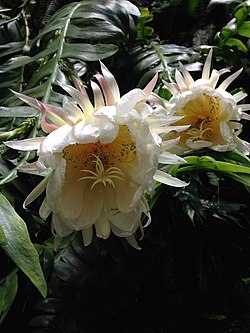Top Qs
Timeline
Chat
Perspective
Epiphyllum chrysocardium
Species of plant From Wikipedia, the free encyclopedia
Remove ads
Epiphyllum chrysocardium (syn. Selenicereus chrysocardium) is an epiphytic cactus[4] endemic to Mexico.[3] It is sometimes called fern leaf cactus, or golden heart epiphyllum.
Remove ads
Description
Vegetative characteristics
Epiphyllum chrysocardium is a large,[5] epiphytic plant[4] with pale green flat, fleshy stems, up to 1.8 m long,[6] and up to 30 cm wide phylloclades.[5]
Generative characteristics
The nocturnal, white, fragrant flowers are 30–35 cm long. The filaments are golden yellow.[5] The stigma has 12–13 lobes. The green, globose, 5–6.5 cm long, and 4–5 cm wide fruit[4] is densely covered in bristles.[5]
Remove ads
Taxonomy
It was published by Edward Johnston Alexander in 1956.[3] It used to be the only species in the genus Chiapasophyllum, in addition to a former inclusion in the genus Selenicereus (commonly referred to as the fishbone, ric-rac or zig-zag cacti), but molecular phylogenetic studies show that it belongs to Epiphyllum.[7][8]
Etymology
The specific epithet chrysocardium from chryso- meaning gold[9] and -cardium meaning heart[10] means gold-hearted.[5]
Remove ads
Habitat and distribution
It occurs in the Mexican states Chiapas and Tabasco in montane cloud forests.[4]
Conservation
Epiphyllum chrysocardium is a threatened species.[4] The IUCN conservation status is data deficient (DD).[1] The trade falls under the CITES Appendix II regulations.[2]
References
Wikiwand - on
Seamless Wikipedia browsing. On steroids.
Remove ads



